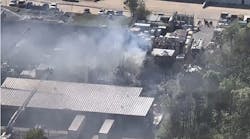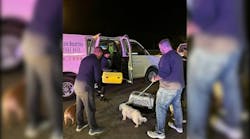Firefighters aren't capable of responding to calls within nationally recommended time frames in certain parts of Albuquerque and Bernalillo County, especially areas around the city-county border, according to a new study from the international firefighters' union.
The study, completed earlier this month by the International Association of Fire Fighters, points to limited manpower, not enough fire trucks and a lack of real-time communication between the Albuquerque and Bernalillo County fire departments as primary reasons for gaps in service.
It recommends new ladder trucks for each of the departments -- and staffing them with four firefighters apiece instead of three -- additional pumper trucks for AFD and three new battalion commander positions for AFD.
Albuquerque Fire Chief James Breen disputed parts of the union study, saying the department is meeting national safety standards, but agreed with other aspects.
Meanwhile, as this study was being released, another was being completed by a consultant hired by Mayor Richard Berry's administration to find ways to cut costs in city government. A draft copy of that report from Matrix Consulting Group, obtained by the Journal after a public records request, lays out a different vision of how to move the fire department forward.
As possible places to cut expenses, the Matrix report questions whether AFD is "over-responding" to fires and whether the department needs two paramedics on each rescue unit. It also recommends ending the practice of staffing the AFD dispatch center with sworn firefighters.
No need to panic
While union officials say their findings shouldn't send the community into a panic, they say the 108-page study serves as a template to plan for the future of departments that have been making do with limited resources in the face of increasing population and calls for service.
"This study demonstrates that we can dramatically improve public safety if we develop a plan to make moderate investments in our current system, such as professional communications, dispatch and additional units and personnel," said Diego Arencon, president of the IAFF local 244.
The local IAFF requested the study from its parent organization, which provides similar studies to its affiliates nationwide.
The union's study of AFD's response capabilities recommends two new ladder trucks for the department.
Arencon said those could cost between $750,000 and $1 million each.
The three battalion chief positions recommended in the study would cost about $340,000 annually, he said.
He is asking that the recommendation be budgeted for over time.
AFD's budget for the current fiscal year is about $70 million. That's an increase of about $500,000 -- or less than 1 percent -- from the previous fiscal year.
Breen agreed with several aspects of the study -- in particular that fire and rescue responses would improve if the city and county merged their dispatch centers.
Although there are efforts under way to improve communications between the two departments, they don't use the same computer-aided dispatch software and their radio frequencies aren't synced in real time.
For example, county firefighters often respond to certain calls even though a city firefighter may be closer and vice versa.
"If you're having a heart attack, or your living room is going up in flames, you don't care what color the firetruck is that shows up," Arencon said.
But Breen took exception to some of the study's findings, saying AFD is meeting the national standards by creatively dispatching the resources it has.
"All critical tasks are being performed in a timely manner," the chief said.
The standards, laid out by the National Fire Protection Association, say ladder trucks should have at least four firefighters aboard for calls and should be able to respond to 90 percent of incidents within eight minutes.
AFD and BCFD staff the ladder trucks with four firefighters about 40 percent of the time, and according to the study, current staffing levels and equipment prevent them from arriving within eight minutes in certain parts of the city and county.
First-responding units that provide basic life-support services, including pumper trucks for fires and ambulances for medical calls, should be able to reach 90 percent of incidents for fire and medical calls within four minutes, according to the NFPA standard.
Again, AFD and BCFD don't have the resources to meet the standard in all areas of the city and county, according to the study.
The administrationordered Matrix report says AFD's average response times for first responders are well under the four-minute standard. The consultant's report says AFD doesn't keep statistics that would allow for measurement against the eight-minute standard.
'Having to get more done with less'
According to the union study, the areas AFD cannot respond to quickly enough include: the area around Montgomery and Wyoming NE, Ventana Ranch, the area around Unser and Ladera SW and wide swaths of the city and county east of Juan Tabo Boulevard.
The standards, according to the NFPA, are in place because after four and eight minutes -- depending on the type of call -- the chances of saving lives and property as well as firefighter safety go down. Fire departments across the country use them as guidelines, not as hard and fast policies.
"Saving lives is the reason most firefighters entered the profession, and that is why we think it's important that the public and the policymakers see the information in the study," Arencon said. "If we start implementing some of the recommendations in the study, it will save lives."
Breen said portions of the study are misleading. For example: Although AFD doesn't necessarily get ladder trucks to structure fires within eight minutes, there's still a firefighter at the scene to ventilate the structure in an effort to keep temperatures down and prevent the fire from spreading.
AFD employs about 680 sworn firefighters, more than 85 percent of whom respond to calls for service in the field. The rest work in support divisions such as the dispatch center.
Last year, the department responded to about 82,000 calls for service, officials said. Those figures typically increase by about 10 percent each year.
More than 80 percent of AFD's calls are for medical services.
Arencon said the study presents a snapshot of the department's capabilities as they stand now.
"This doesn't show that our guys aren't getting the job done, because they are," he said. "But we're having to get more done with less. As populations and call volumes go up, we need to prioritize our budgetary needs to meet those needs. As it stands now, our manpower and resources aren't sustainable."
Arencon presented the report to city councilors last week.
"We felt it was important to bring this information to the decision makers in the city so they can make budgetary decisions with as much information as possible," he said.
Copyright 2012 - Albuquerque Journal, N.M.
McClatchy-Tribune News Service





